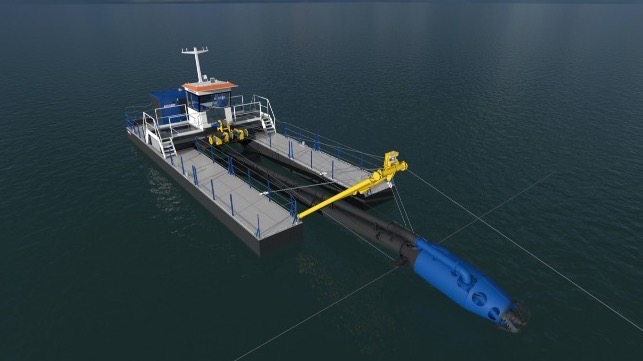DOP Becomes First Locally Built Dredger in Argentina

SPI Servicios Portuarios Integrados for Mar del Plata port in Argentina has acquired a DOP Dredger component package from Damen Shipyards Group. The Argentinian shipyard will build major components and assemble the dredger. The DOP Dredger 250 will be used to dredge underneath a floating dock, which the shipyards wants to keep operational full-time. The trick is that the dock will remain in place during the dredging activities.
The Argentinian ship builder SPI has an extensive yard in the bay of Mar del Plata, located on the South Atlantic Ocean. Beside the newbuild of tugs, fishing vessels and barges, the yard also has a repair division. The 150 metre floating dock is in use round-the-clock for repairing local vessels. Therefore, towing away the dock for dredging activities is not desirable. The DOP Dredger will be built by the yard being the first locally built dredger in Argentinian history.
SPI´s main strengths are based on the productive capacity and infrastructure available for the development of the repair and shipbuilding business.
The infrastructure mentioned is located in the interior of ports (Mar del Plata and Caleta Olivia) and on the banks of Arroyo La Cruz (secondary artery of the Paraná Las Palmas River), in Campana, Buenos Aires.
All the different elevation systems available at the shipyard require dredging maintenance tasks, due to the few natural water depth on the ports. That is why they must be dredged periodically in order to maintain the commercial activities that take place there.
The DOP Dredger, type DD250, is a standard dismountable dredger. The dredge has been designed to remove silt or sand from -2.5m to -15m dredging depth. It pumps some 1.250 m 3 /h using a Ø250 mm pipe line. The total installed power is 395kW. Shipped in only a few containers will be the operating cabin, the power pack, a jet pack as well as the various hydraulically driven winches.
The specific equipment (dredging pump, accessory equipment and control equipment) will be provided by Damen. In the development of this project Damen's engineers worked together with SPI's engineers in a modified version designed on a standard equipment base, which reach the shipyard´s needs and allows them to keep their lifting equipment at 100% of its operational capacity, making business more efficient.
The DOP Dredger DD250 will be able to work in two configurations: with a cutter head targeting compacted soils and with a jet water assisted mining head for easy pumping away loosened bulk sediment. Especially with the compact jet water assisted head, the DOP pump – which is mounted at the bottom end of the ladder – will be able to reach the pit at - 11m underneath the floating dock. Due to continuous tidal movement and traffic in the busy post, each year a layer of silt of some 30-40 centimetres is built up underneath the floating dock.
As a complement to the main activity on which this investment is based on, the dredger will also be available for any port infrastructure need, with the possibility of being moved and easily assembled on where it is required.
The DOP Dredger will not be used in Mar del Plata only. The modular construction of the dredge enables easy transport by road. SPI is planning to relocate the dredger regularly to their other two shipyards, being Campana Port – some 80 kilometres north of Buenos Aires – for the maintenance of another yard including floating dock. The trucks will also transport the DOP Dredger some 2,000 kilometres south to the Caleta Paula shipyard for the same maintenance duties, ensuring maximum uptime of the local ship repair facilities.
Mr. Ciceri, SPI’s Purchasing Manager, comments, “We are happy to build the first dredger in Argentinian history. The dredger will ensure our independence so that we will be able to operate our floating dock more efficiently.”
The products and services herein described in this press release are not endorsed by The Maritime Executive.
